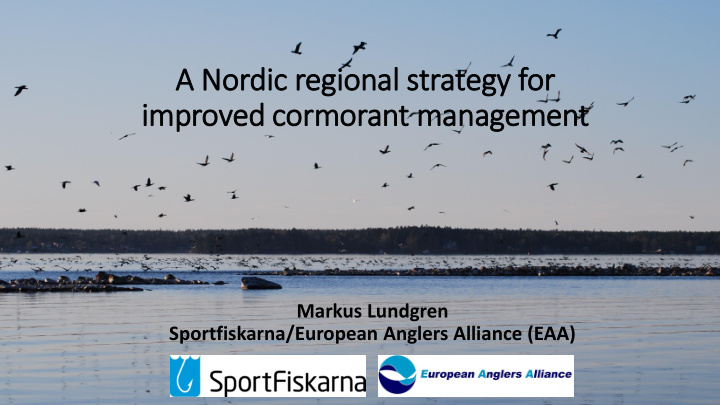



A Nordic regional strategy for improved cormorant management Markus Lundgren Sportfiskarna/European Anglers Alliance (EAA)
The problems: • Overexploited/weak fish stocks • Adult birds eat mainly fish • Feces from colonies kill green plants • Effects on other birds (Caspian tern) • Effects on biodiversity?? Concern and resistence
The Swedish Roxen report • 1992: first established colonies in lake Roxen • 1999: 908 couples nesting (March – September) • Fish – both species composition and size distribution has changed • Angling heavily restricted (bag limit etc.). One commercial fisherman left.
The Swedish Roxen report • Recommended outtake of fish: 3-6 kg/ha (100 x 100 m) • Commercial fisheries: 0,85 kg/ha • Cormorants: 7,50 kg/ha Conclusion: cormorants take the major part of the fish stock and has an effect on the stocks. Cormorants probably the main reason that most of the fish doesn´t reach reproductive size Suggestions: manage the cormorants to get the fish outtake back to sustainable levels, by: - lowering the nesting/breeding results (but how?) - Scaring off migrating cormorants - Good documentation
Why improve management? • Fast expansion of the continental cormorant ( Phalacrocorax carbo sinensis ) in Europe historically high population numbers ( Finland 1996-2002: 10 16 007 br. pairs ) significant impact on (the recovery of) local fish stocks breeding sites vs. landowner interest concern and resistance • Highly protected – but why today? - sub-species complexity • Cormorant vs. fish stock management • Lack of cooperation between MS • Management uncertainties in member states
Why a Nordic cooperation? • The geographical distribution of the continental cormorant implies a regional approach
What do we want? • The protection of weak fish stocks and threatened fish species shall be considered more important than the protection of species with a positive stock status • In areas of importance for fisheries, especially angling and angling tourism, more active measurements shall be carried out if the cormorants cause a considerable damage on the fish stocks (limit/eliminate colony). • The national authorities handling cormorant management in the Nordic countries shall be given the responsibility to survey and follow up the effect of the cormorant populations on the fish stocks. • National councils (like in Denmark) • Nordic (+ Germany) cooperation/forum/council between the authorities • European strategy – “BEST PRACTICE”
Recommend
More recommend